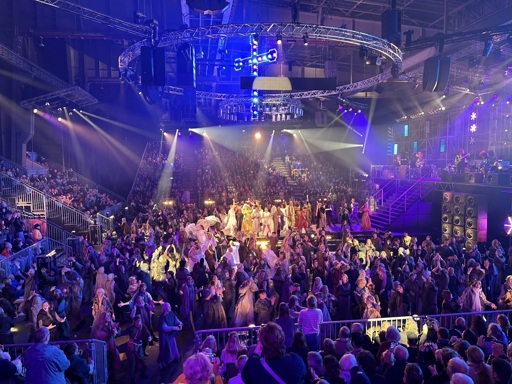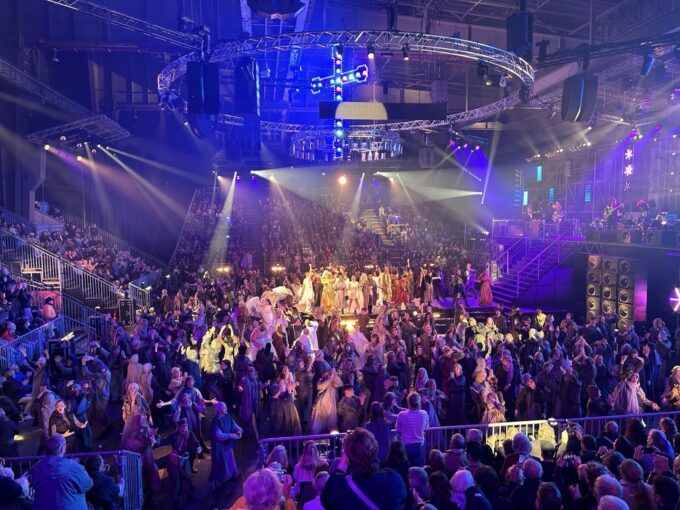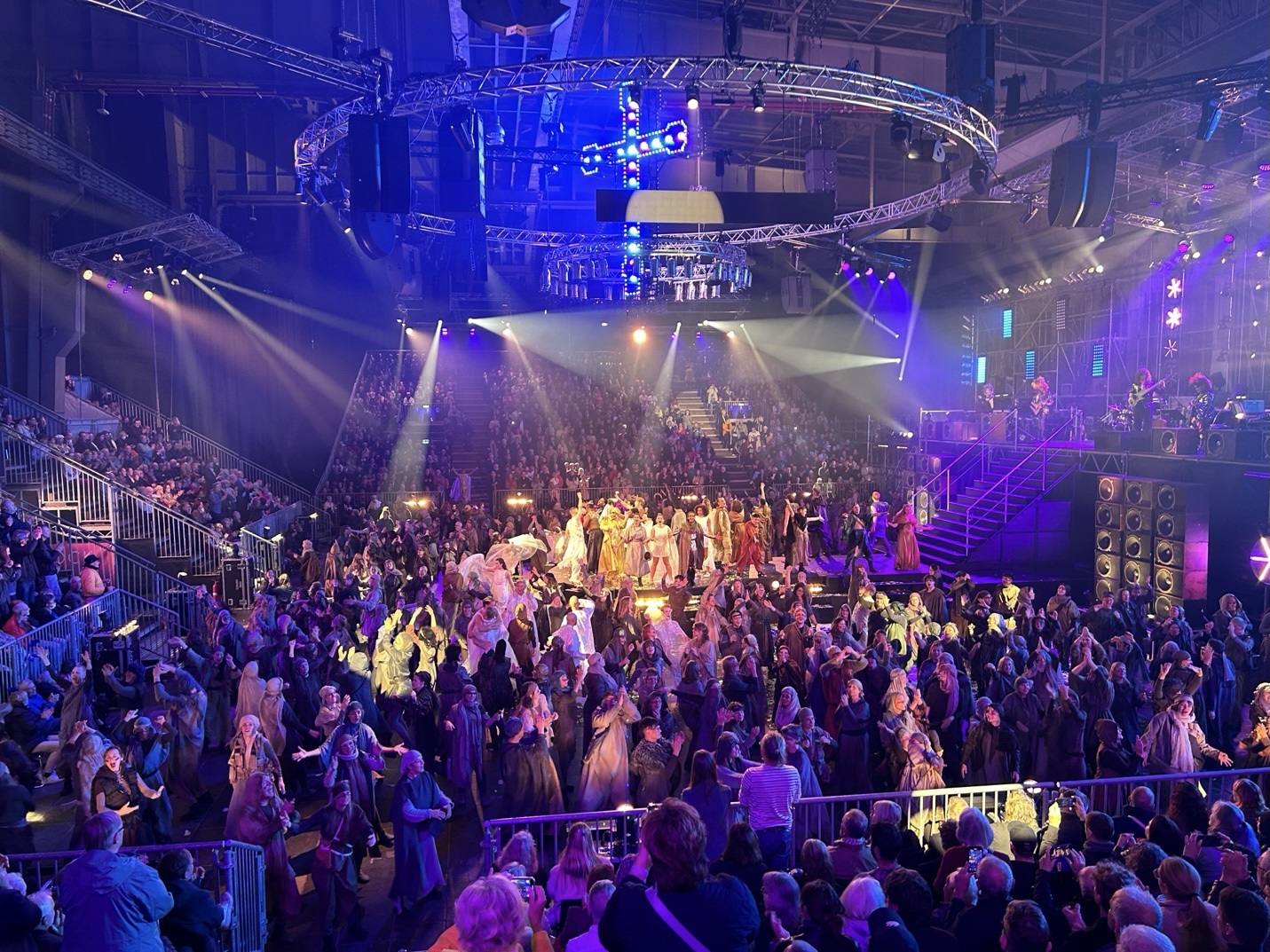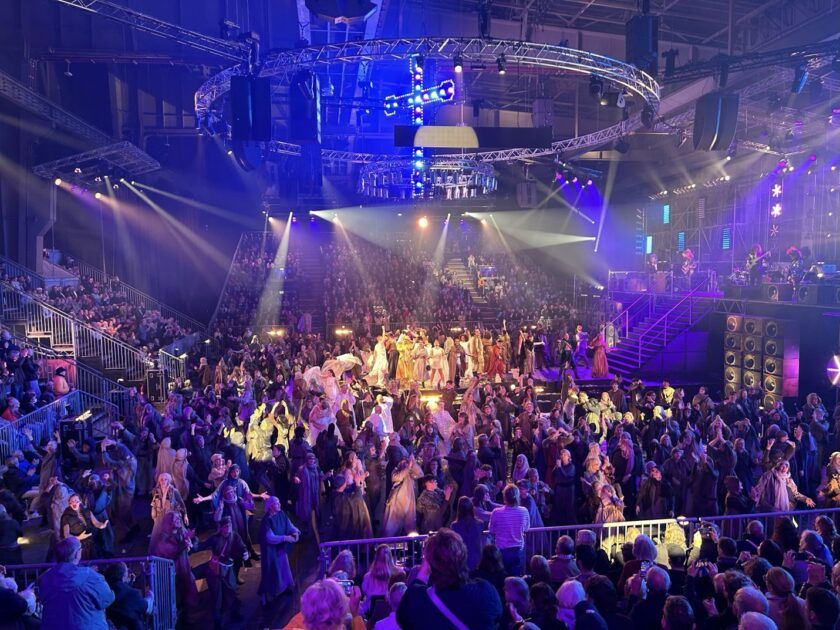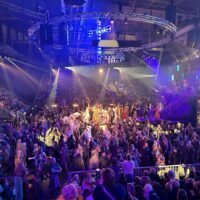Jesus Christ Superstar, Tempelhof Airport, Hangar 4, Komische Oper Berlin. Photo: David Yearsley.
Founded in 1947, the third and youngest of Berlin’s great opera houses is the Komische Oper—the comic opera. In the rubble of war, it took up residence in the late-nineteenth-century Metropol-Theater, beloved for its racy revues and risqué operettas. The Nazis had closed the place down in 1933, then began to stage their own Volk-friendly entertainments there under the auspices of the party’s Kraft durch Freude initiative.
The neo-baroque building stood only a few blocks from the Brandenburg Gate and was badly bombed in the war. But the auditorium itself, with its mirrors and chandeliers and gods and goddesses of muscly and curvaceous stucco, was left virtually untouched by the destruction. The show could go on and did.
The wrecked foyer and façade were eventually redone under the socialist East Berlin regime in clean, modernist lines that worked in bracing counterpoint to the louche interior.
Since its founding, the Komische Oper has reaped admiration and condemnation in nearly equal measure for productions that are often wildly creative, convention-defying, and graphically scandalous. The house does not shy away from confronting many of the underlying currents troubling the depths of opera (viz., violence, misogyny, racism), nor does it apologize for its sometimes almost X-rated depictions of liberation and pleasure.
Nearly eighty years on since the birth of the Komische Oper, its building is now in the midst of a renovation set to cost nearly 500 million euros, an outlay decried by the likes of the rightwing tabloid Bild-Zeitung as an outrageous luxury in a time of retrenchment in the city-state of Berlin.
While the work goes on despite such grumblings, the Komische Oper has taken up provisional residence in the Schiller-Theater a couple of miles to the west, but the company launched its fall season offsite with an eye-popping earwax-cleansing production of Jesus Christ Superstar in the spectacular venue of the former Tempelhof airport. This airfield was opened in 1923 but massively expanded by the plane-crazy Nazis from 1936 to 1941 until the long curve of its bays and hangars had occupied more surface area than any other building in the world. That dubious distinction was eventually overtaken by the American Pentagon.
As the Russians closed in, in April of 1945, Hitler’s orders that the airport be blown up went unexecuted, so that the enormous building stands still. It was used by the Americans in the Cold War, most famously during the Berlin Airlift that thwarted the Russian Blockade in 1948-9. Tempelhof was closed to flight traffic in 2008 and various parts of the humongous structure now host exhibitions and spectacles put on by the likes of the Komische Oper.
The airfield itself is currently a park visited by nearly 100,000 people on non-rainy days. Kite surfers, skateboarders and cyclists wheel and wing across the wide, windswept spaces. Cricket matches take place in the shadow of the radar tower. If only all airports could be converted to democratic, carbon-sinking, low-decibel open spaces on the Tempelhof model and all the world’s concourses and hangars dedicated to theater and the other arts!
We arrived at Tempelhof on a clear, autumnal Tuesday evening. Along the access road leading into the hangar, a group of a dozen or so Catholic protestors recited the Hail Mary while holding up a banner that read “Blasphemy: Hate Against Christians.”
I wanted to ask the Catholic critics if they’d seen the show. If they had, they’d realize that this is just a trashy Passion Play, not so different in its theological underpinnings—or lack thereof —than kindred spectacles like the five-day reenactment in Oberammergau, which got going four hundred years ago and has thus had an even longer run in the Bavarian Alps than did Andrew Lloyd Webber’s Phantom of the Opera on Broadway.
Whether they liked it or not, the protestors were themselves part of the show, a pious prelude that reminded the undeterred audience that forbidden fruit is the sweetest and juiciest.
We followed the crowd in and stowed our bikes on a couple of the hundreds of stands already filling up—another happy testament to Berlin’s bike-and-arts friendliness and a reminder that the Wright brothers were into the bicycle before they became the first in flight.
The Komische Oper has real flair, whether putting on a show in an opera house or in an empty airplane bay looking out at a dusky runway. In an ad hoc bar area the size of at least two football fields, sofas had been set up with more than ample space between them. The clink of champagne glasses echoed off the trusses high up in the cantilevered dimness. A neon sign marked off this vast ad hoc opera foyer from the airfield beyond, resisting the gathering dark with its message of #allesaußergewöhnlich (everything extraordinary). That said it all—in lurid pink.
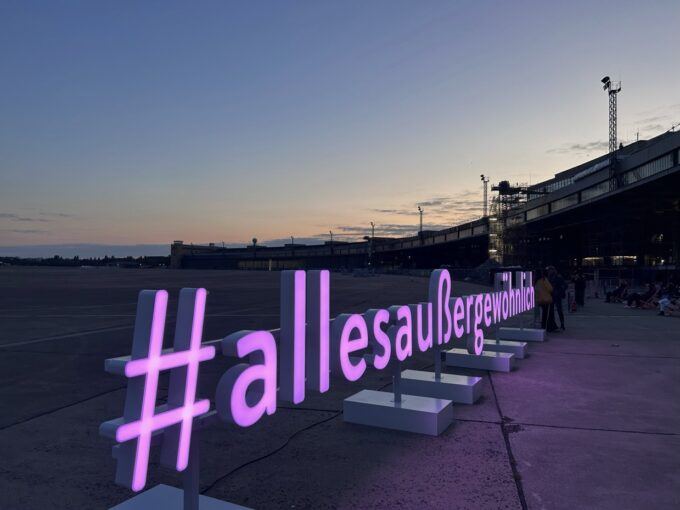
Lurking on the tarmac beyond the cordon, the silver hull of a Douglas C-47 Rosinenbomber (raisin bomber), one of the planes that supplied Berliners with food during the blockade, held the last of the twilight on its silvery skin.
The bell rang and the crowd streamed into Hangar 4. Metal grandstands rose up on three sides of the cavernous cube. At the front of the stage glowered a cross built from metal poles and struts housing headlights, looking as if it could have done service controlling plane traffic out on the runways.
The band, fronted by three guitarists, a keyboardist, and a drummer, was arrayed along the fourth wall on a higher platform with stairs leading down to the catwalk stage. The Komische Oper orchestra strings and woods spread out behind and to either side. Miraculously, given the sprawling space and ever-changing formations pushing into every corner, music director Koen Schoots maintained discipline, yet fostered feeling.
The cavernous hangar was filled to capacity—enough people to fill several 747s—and all were ready for a theater evening that, in the end, brought everyone into the show in a singalong encore of the title tune.
Throughout, Dancers and Disciples, Money Changers, Priests and Judges rushed in from entrances that seemed to lead out to the airfield itself and also scampered up the metal stairs and into the audience. The messianic mob was worthy of Cecil B. DeMille in scope and energy and rustic Levantine textiles. Andreas Homoki stage direction was devoted to excess worthy of Berlin, encouraging seething movement but also leaving space for poised prayer.
Andrew Lloyd Webber is not renowned for his musical originality, having settled at least one copyright infringement case over the years and been threatened with others. He shamelessly appropriated the theme, and much else too, from the slow movement of Mendelssohn’s Violin Concerto for the show’s biggest hit, the oft-excerpted ballad, “I Don’t Know How to Love Him.” There is ample precedence for such plagiarism, even if done far more skillfully, in the oeuvre of Lloyd Webber’s predecessor as top dog of the London musical theater— George Frideric Handel. Luckily for Webber, Mendelssohn’s copyright expired a while back.
The dynamic choreography by Sommer Ulrickson, whether animating the unwashed masses or the serpentine apostles, shifty priests, or slinky Motown soul sisters, was exuberantly varied and inventive. Frank Wilde created the colorful, even crazy costumes, from diaphanous and billowing, to form-fitting and crotch-hugging. The enthralling Albert-Speer-at-Studio-54 lighting was conceived for maximum wow-factor by Olaf Freese and Florian Schmitt.
Jesus was not the bearded, long-locked waif of medieval carvings and Renaissance portraiture but instead close-cropped on top and muscle-bound all the way down from there. Had the engrossing and literally gripping Ryan Vona walked on water during the show, the miracle would have been all the more impressive given the body density. But he could sing, nailing (sorry! Will say 10 Hail Mary’s and buy an extra indulgence from the Editor during the current fund drive) the high notes and wringing more than the requisite emotion out of librettist Tim Rice’s embarrassing doggerel (viz. “tables, chairs and oaken chests would have suited Jesus best / He’d have caused nobody harm – no one alarm!”). In scarlet-letter red evening gown and shaved head, Ilay Bay Arslan sang the part of Mary Magdalena with an allure both sin-soaked and purified.
As the man-bunned, clog-sporting, eventually shirtless Judas, Ryan Shaw effectively and effortlessly toggled between keening falsetto and full-throated song, between anguish and affection.
If you’re going to stage a show at the Nazi Airport, the bad guy had better steal the show, and he did.
The post Flights of the Imagination: Jesus Christ Superstar at Tempelhof Airport appeared first on CounterPunch.org.
From CounterPunch.org via this RSS feed


